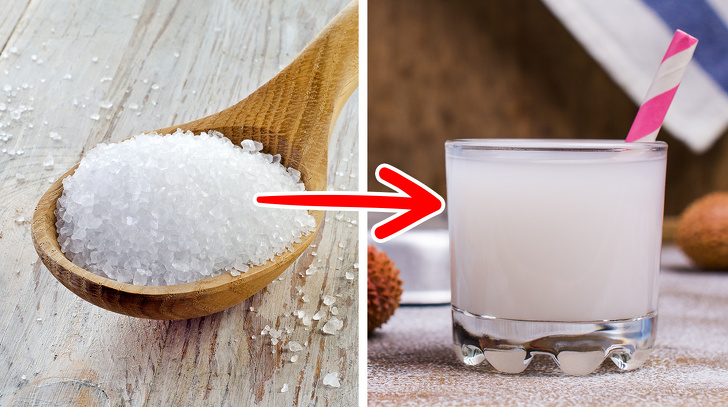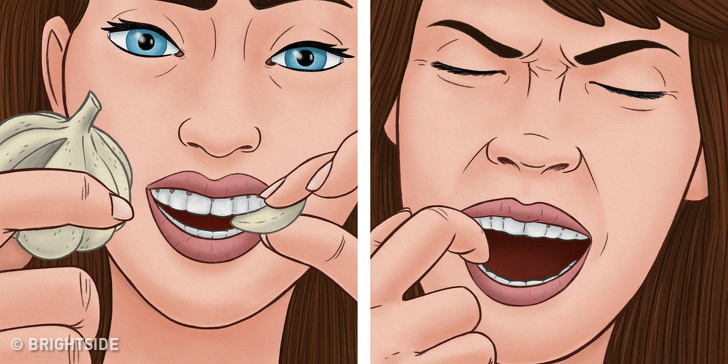
There are more than 3 billion people suffering from dental problems around the world and the number has been rapidly rising over the last few years. A toothache is something that we’ve all experienced in the past and there are dozens of causes that can lead to a toothache. For example, loose fillings, cavities, cracked teeth, or even a sinus infection.
Until you are able to visit the dentist, we at Bright Side found these trusted home remedies that can relieve a toothache.
1. Clove Oil

Clove oil has a variety of health benefits, however, it is most famous for reducing pain which is associated with dental issues. Cloves are used in Chinese medicine as a remedy to numb the nerves. One of the main chemical elements of the spice is Eugenol which is considered a natural anesthetic.
Nevertheless, clove oil should be used very carefully. For example, pouring the clove oil directly on the affected area can, in fact, worsen the symptoms and irritate the tongue and sensitive gums.
How to use:
2. Sea Salt:

Celtic Sea Salt is known to offer numerous health benefits such as building immunity, regulating heartbeats and blood pressure, alkalizing the body and relieving toothache. Sea Salt contains natural antibacterial properties that will alleviate the symptoms of a toothache caused by gum disease and kill bacteria that are causing an infection. Furthermore, Celtic Sea Salt contains over 60 traces of minerals and can help in healing wounds faster and more effectively.
How to use it:
3. Peppermint Tea Bags

Peppermint tea bags can be used as a temporary solution for a toothache by numbing the pain and soothing sensitive gums. Wet, used tea bags are often used to calm sensitive/irritated skin and gums. Furthermore, peppermint has numbing properties which are analogous to clove oil and it is very effective when it comes to relieving a toothache. In addition, peppermint tea is abundant in tannin — a natural antibacterial and anti-inflammatory agent.
How to use it:
Take a used teabag and let it cool down, then, apply it on the affected area for half an hour.
Take a used teabag and place it in the freezer for a few minutes until it becomes cold. Then, apply it on the affected area for half an hour to relieve pain.
4.Onions

Onions have a lot of antimicrobial and anti-inflammatory properties that can kills germs in the oral cavities, prevent them from spreading, and avert tooth decay. They can also kill bacteria that cause infections in both teeth and gums and stop gum bleeding, which makes it an ideal home remedy for relieving pain, curing irritated gums, and preventing decay.
Furthermore, onions have volatile sulfur compounds that, when they come in contact with saliva, form sulphuric acid which can give the tooth a numbing effect, thus relieving pain.
How to use it:
5. Cold Compresses

Using cold compresses is an older pain-relieving method when it comes to any kind of discomfort. By applying ice to the affected area, it can numb the nerves that cause you pain and reduce swelling and inflammation. Furthermore, ice also causes the blood vessels to constrict so that they do not allow enough blood to pass through, thus making the pain less severe.
Do NOT apply ice directly on the irritated tooth because this can make the pain a lot more severe. Make sure you wrap a piece of cloth around it to protect it.
How to use it:
6. Wheatgrass

Wheatgrass is filled with various nutrient combinations that make it extremely useful for our overall health. It is packed with vitamins and minerals, and it has antibacterial, anti-inflammatory, and antioxidant properties. It can help to heal the body from the inside out if you ingest it.
It also has the ability to rapidly reduce inflammation of the mouth and prevent bacterial infections from spreading and developing in the future. Furthermore, wheatgrass is high in chlorophyll which can fight infections.
How to use it:
7. Thyme

Thyme is an herb that comes from the mint family and it is packed with antimicrobial and antibacterial properties. It can be used as an antiseptic and a disinfectant. It can also kill germs and be used as a pain reliever.
Furthermore, thyme is one of the key ingredients in Listerine because it has the ability to kill germs that cause bad breath. In addition, a recent study has found that thyme is the natural version of ibuprofen.
How to use:
8. Garlic

Garlic is a great source of phytochemicals, which are responsible for fighting various infections and help boost the immune system. Garlic has the ability to kill harmful bacteria in the mouth that causes plaque and it can act as an effective pain reliever. Furthermore, garlic contains allicin which is proven to prevent tooth decay and kill germs that cause cavities.
Please note that all these methods are temporary and that a visit to the dentist is the only way to know the underlying cause of the pain.
Have you ever experienced a toothache? How did you deal with the pain? Please share your story in the comments below!











